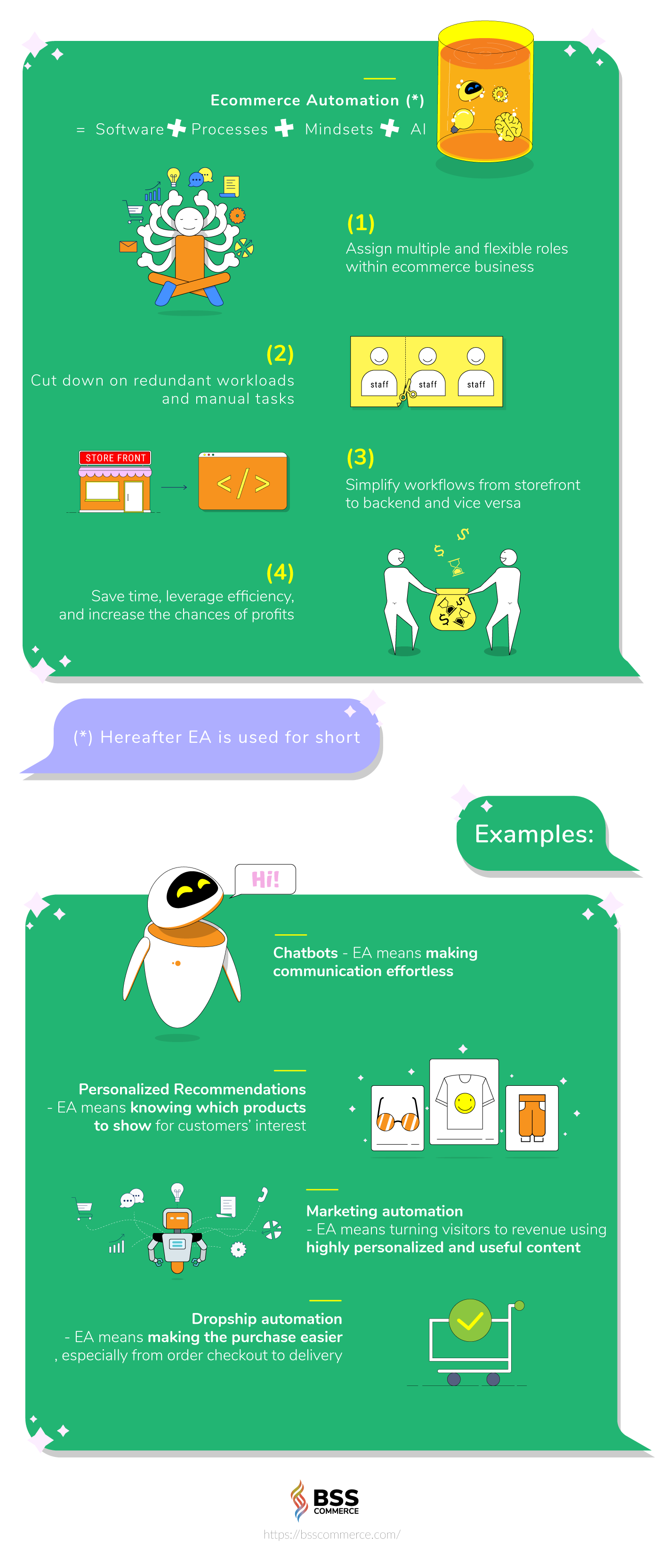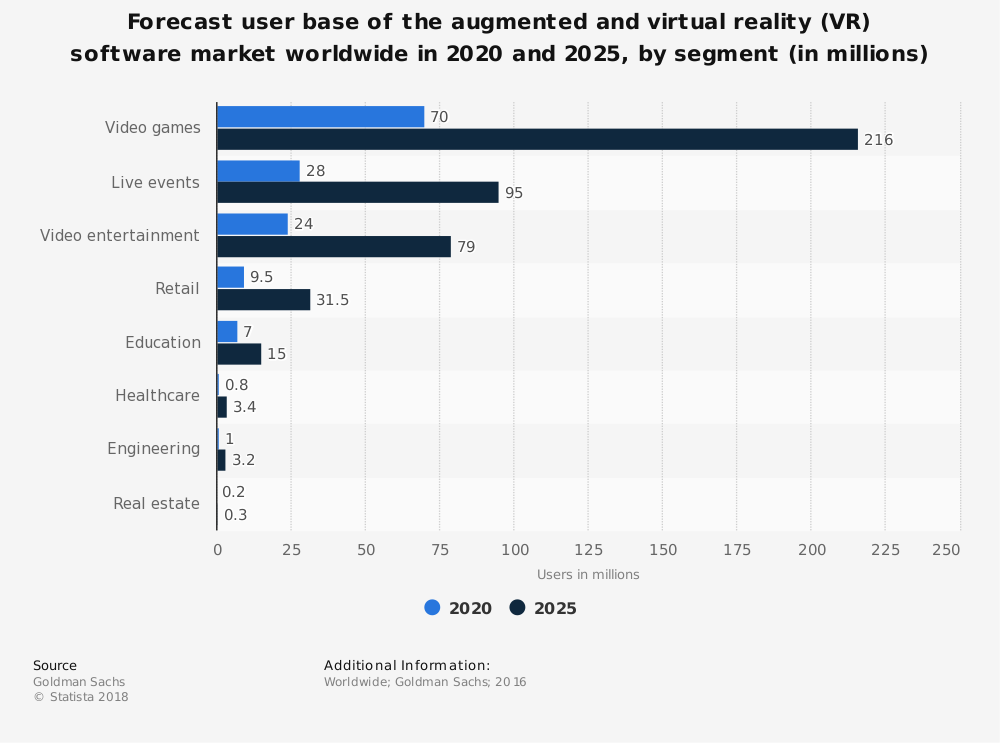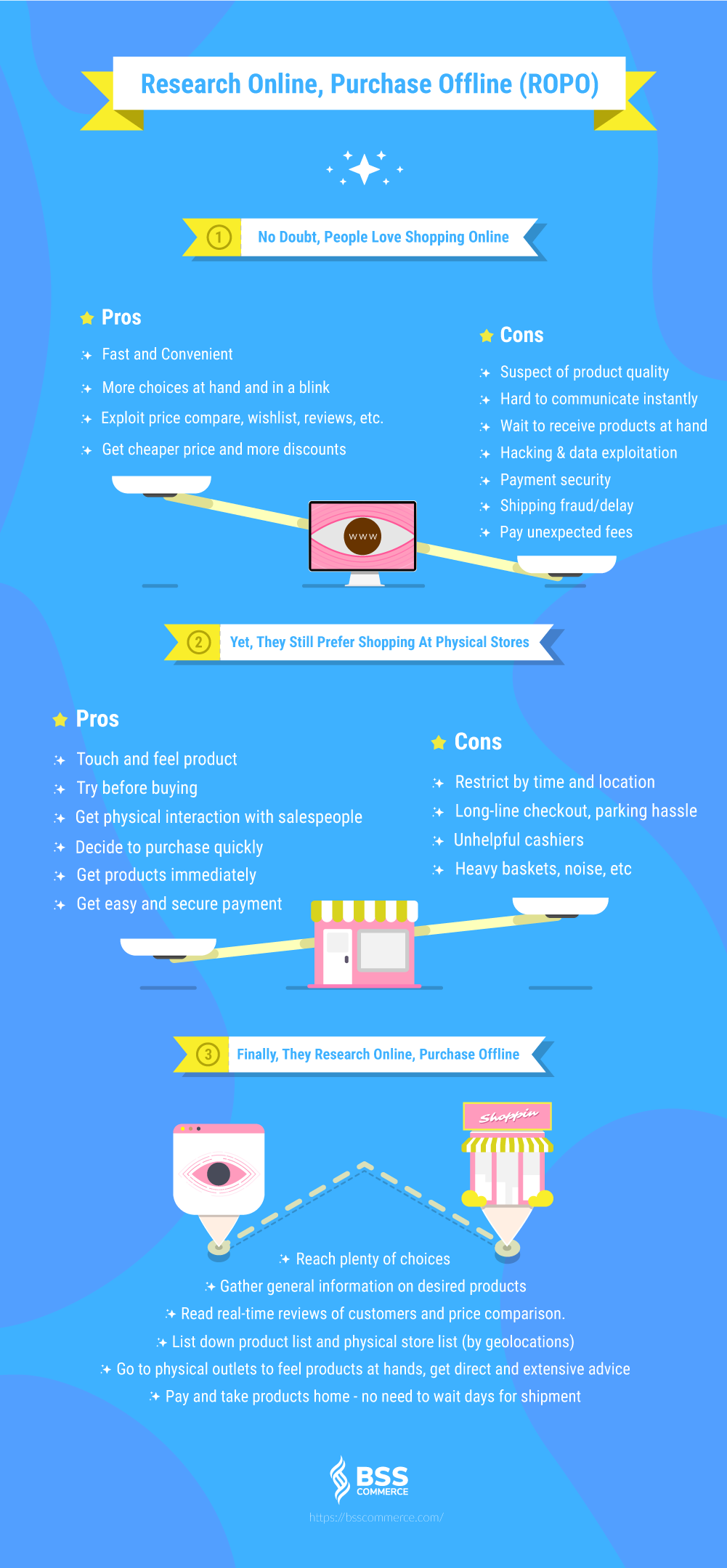Demands of consumers, especially online consumers, are ever-changing according to advances in technology. Hence, if you want to be successful in the e-commerce world, think several years ahead. And, talking about the future, we talk about Magento 2 e-Commerce TRENDS.
In this article, BSS Commerce discusses 7 Magento 2 eCommerce trends that will shape e-commerce activities in 2020 or even beyond. There are some familiar terms you have heard over the past several years, yet they are still hot. The others might be completely new. Whichever, you need to update yourself to stay in advance.
More importantly, let’s see how Magento has improved its platform to catch up with these e-commerce trends and what to improve more.
#1: Mobile First and Desktop Goes After
Table of Contents
Safe to say that millennials and the young account for the majority of online shoppers who love purchasing via the internet and using smartphones than any others. Specifically, one survey by BigCommerce in 2018 revealed that millennials and Gen Xers spent 6 hours, nearly 50% as much time shopping online each week compared to four hours spent by their older counterparts.
The traffic to e-commerce websites from mobile devices is also overtaking that from desktop or tablet thanks to its light content and convenience to access all the time and at all places. However, people mostly browse on mobile while finally purchasing on the desktop. The reason is that they feel more secure on the desktop and it is also easier to read the product or service in detail.
Such a fact demonstrates mobile commerce will soon dominate how customers access your website and become one of the most noticeable Magento 2 eCommerce trends. Yet, there is still a lot-lot to improve to make every experience on smartphones shoppable and convenient so that they need not purchase on the desktop anymore.
Progressive Web Applications (PWA)

Check NOW >>> Magento 2 PWA Theme Studio: The On-trend Technology
One solution to optimizing mobile commerce experience is to offer mobile apps. However, it is costly to build and maintain one native app. Not to mention, online users hardly install any app except for those of their frequent and loyal brands. In that situation, the Progressive Web Application (PWA) has been developed and predicted to become a new standard – very soon! This technology will be the future of mobile web browsing in general and mobile commerce in particular.
The concept of PWA is based on several main points as follows:
- Make the user experience reliable (loading instantly without showing the Tyrannosaurus “downasaur”), fast (responsive and interactive with users in real times using smooth animations and no janky scrolling) and engage (providing app-like experience right on mobile sites.)
- Support a new set of APIs: PWA studio makes essential functions (e.g. synchronizing and receiving data, predictively pre-loading content, sending push notifications) quicker and more progressive.
- Improve SEO juice: Keep in mind that Google considers user experience among the most critical criteria to rank your web, As PWA technology makes fast and reliable experiences, it will lengthen time on page, reduce bounce rate, then improve SEO value.
- Work on all devices: Here, we focus on discussing the mobile experience; however, PWA is more than that. PWAs can and should be developed to be responsive on various screen sizes across mobile, tablet, and desktop.
Does Magento support PWA?
Hopefully, the Magento team knows this trend. Thus, in April 2018, they announced the Magento PWA Studio project to build eCommerce websites having app-like experiences. Great!
However, PWAs are currently available in Magento Commerce 2.3 only. And, rather than a ready-to-use solution, it provides a set of tools for developers to bring these above ideas into reality. In other words, in 2020, there is a long way and open opportunities for the Magento team, Magento merchants, as well as Magento solution vendors, like BSS Commerce.
TAKE A LOOK at our Magento PWA Development Services right now!
#2: Best Magento 2 eCommerce trends: Automation & Chatbots
Some of you might have heard of chatbots as the Magento 2 eCommerce trends in 2019. Why do still I mention it for your goals in 2020?
The fact is there are lots of potentials to unlock when it comes to automation and chatbots, especially in the customer service stage.
Automation

Chatbot
Thinking about automation in Magento 2 e-Commerce trends in 2020, we should talk about chatbot.
Every merchant needs to know that the common reason physical commerce still overweight eCommerce is that consumers feel shopping online lacks instant communications. Just imagine sending a message via an online website then waiting hours or even days to be replied. None will feel ease with such annoying and slow experience.
That time, chatbot function plays the role of a smart alternative to human customer care experts to immediately interpret customers’ needs and respond to them as quickly as possible using advanced technology.
So, what is a chatbot and how it works?
Have you used an iPhone and asked Siri “What’s the weather like today?” – Then, you have already worked with a chatbot.
Let’s go more in-depth with the example below:

Supposing that your online stores supported chatbot. That time, customers would send some requests by text or voice instead of browsing webpage by webpage themselves. Then, the chatbot will predict and respond as accurately as possible and almost immediately based on already-made scripts or its self-learning scenarios during the interaction with customers.
For example, the chatbot might skip one request that is not recorded in its database. However, it will remember and “imitate” this request in regular conversions later, if any. This process is backed up by Artificial Intelligence (AI)
Why is chatbot one of Magento 2 e-Commerce trends?
- “Messaging is one of the few things that people do more than social networking.” – Mark Zuckerberg. Hence, who will miss this means to turn online users into customers?
- Chatbot supports real-time conversations to optimize and speed up the shopping process.
- A chatbot conversation is somewhat personalized, which increases the likelihood and value of sales.
- The chatbot will cut down on human cost and time for customer care by automation, for sure.
Does Magento support chatbot?
By default, the answer is “No.”
However, there are various free and paid Chatbot extensions to bring this fantastic feature to your Magento 2 sites. Please note that the scope and complexity of chatbot depend on the algorithm of the creator. As can be seen from the example of Ray-ban, the chatbot can support and navigate customers from searching, browsing to checking out the product. Hence, based on your business purposes, make a wise choice.
#3: Voice Search
People search by voice for ages. This is definitely not a new term.
Yes, I am a fan of voice search that whenever I go for Google, I “ask first, text later.” Many others have a similar habit – the following statistics prove my words:
- 58% of consumers have used voice search to find local business information within 2018
- 27% visit the website of a local business after conducting a voice search
- By 2020, 50% of all searches will be voice searches
- Google’s AI read over 2,865 romance novels to improve its conversational search abilities (Just fun fact :D)
In 2020, if you still do not optimize your eCommerce site for searches by voice, your competitors will.
Here, 4 quick tips for voice search optimization as Magento 2 e-Commerce trends
- Understand what your target customers search for: their pain points, their habits, their word choices, etc. Then, build the FAQ page or create content relevant to questions.
- Answer questions clearly and concisely. Usually, when customers use voice search, they are on the move or in a hurry. Then, make the answer clear and straight to the point.
- Optimize long-tail keywords. Rather than typing pieces of separate keywords in the text box, voice search allows users to ask in more detail. Thus, think about long questions when creating your content. Believe me, integrating long-tail keywords is not complicated work. If you put yourselves on your audiences’ shoes and write in a natural, conversational tone, there is a likelihood that you’ve already included them in your website’s content.
- Get updated on voice SEO. Voice search and text search has many differences. Hence, to bring your website up for search by voice, get your attention to the following SEO factors: well-structured content and data, featured snippets, local SEO, load speed.
Does Magento help me to improve voice search?
For the time being, you can not add a voice search to your Magento 2 websites by default. This task, however, can be done by Magento 2 extensions. Right after completing this article, you can go for Google or Siri, asking “Hey Google/Siri, show me free and paid Magento 2 Voice Search extensions?” Check the result, and you might find one that fits your needs.
About voice SEO tips as above, you must invest some time to think about your content strategy in 2020, add it values of voice search.
Bonus to Read NOW >>> An interesting post about voice SEO strategies for your thought, later.
#4: Product Visualization: Virtual Reality & Augmented Reality
Still being impressed by how a chatbot can add a personal touch to both buying and selling experiences?
Then, Virtual Reality and Augmented Reality will be much to your surprise when being placed into an eCommerce business to bring product visualization to a new level.
The importance of product visualization

CHECK OUT Magento 2 Gallery extension to improve product visualization
“Seeing is Believing!”
Explosive as the internet and eCommerce become in the 21st century, consumers still love shopping at stores. Factors like direct visualization, smells, sounds, and physical human interaction might be unique at a brick-and-mortar only.
Hence, online merchants try to make their products as visual as possible using gif, video introduction, live stream, etc. These things seem still effective – I totally agree. Yet, if you find a better way to make product visualization better than any of your competitors, you will win and stay ahead, far ahead.
Virtual Reality (VR)
VR technology helps create a realistic three-dimensional (3D) environment with a mixture of hardware (e.g., VR headset or controllers) and software, in which consumers feel interactive and physical-like. When they turn head, the virtual world turns with them.
Mentioning VR, most of you think about video games or blockbuster movies. Yes, they are the popular uses of VR, now and in the future. However, people predict the role of VR in the ecommerce segment will become more and more significant. It makes products in the “virtual” places more “real” and “purchasing-persuasive.” – An art of marketing process.

Picture this:
You run a natural cosmetic store that offers VR experience. Online shoppers put on their VR headset and shop around your website right from their home, and even in their pajamas.
That means they can get the product off the shelf and view it in 360 degrees. Even more, you can tell the story behind how you source and manufacture that product. First, take shoppers deep down the sea to get fresh seaweed. Then, showcase the local beekeeper house where you buy honey for your facemask. Next, welcome shoppers to the laboratory in which you mix natural ingredients into perfect cosmetics.
This is how you add value to your products and persuade customers to buy and become your advocates.
Augmented Reality (AR)
Many of you might confuse VR and AR, are they the same?
In fact, AR is far simpler than VR. It is to place “virtual” things to “real” situations rather than create a totally fantastic world from zero. Here is the Augmented Reality app by IKEA:
(Source: Youtube IKEA)
Augmented Reality fits well with your eCommerce business since it provides a way-fun experience for shoppers to “TRY BEFORE YOU BUY.” You can learn from what IKEA does or more. For instance, in your lipstick product page, spend a room for AR experience by replacing the “add to cart” button with a “try.”
When customers choose to try a product, they can put the color on themselves or use a default model. That time, the AR function is somewhat similar to Snapchat’s filters.
Does Magento support VR and AR?
You love the idea of VR and AR to leverage customer experience and grow your sales. Then, you wonder whether to invest VR or AR in your Magento 2 website.
Obviously, the default does not have any function like VR or AR. There is also hardly Magento VR/AR extension. However, thanks to the Magento team that this open-source platform is freely customizable. So, if you have a budget and a plan to develop your Magento 2 website, think about VR/AR from now.
#5: Video Content
As can be seen from above, product visualization is vital in the eCommerce segment. Employing VR or AR technology is a great idea, yet it takes time and money. Before you are ready for such big things, start with a simple method – Video Content.
Engaging videos sell products
If a product image costs a thousand words, a video costs a million ones.
Honesty, talking about content creation in general and making video content in particular, there is not the right way to follow. Just keep some recommendations in mind:
- Tell a story instead of showing off your products or business too directly
- Keep it simple, natural, and short of 30 seconds or a bit more
- Blow into your video content a human touch
Here the one I like. It brings me a humorous feeling of the brand, get the presence of its niche product line.
Here the one I like. It brings me a friendly feeling of the brand, get the presence of its niche product line. And, it is short and straightforward without a single verbal word. Just personal taste but I replay it five times already – Everybody should have a Nine Line Apparel Hoodie 😀
Does Magento support Video Content?
If you have lovely videos and want to show them off right on product pages, then hopefully, Magento does allow uploading in several easy steps.
Please note that those videos will be integrated into your website via Youtube API. Thus, before you start, it is important to ensure that you have permission or copyright to upload any content. In other words, I recommend uploading your own content only.
Besides, there are dozens of Magento Video Optimization extensions out there to enrich your content from various sources and make video display even better fascinating. In 2020, investments to leverage your content, especially video content will be profitable.
#6: O2O (Online to Offline) Business Model
Since years ago when eCommerce appeared and developed at an astounding pace, many people have thought of “ retail apocalypse” in which all shopping would eventually go online while physical stores would be doomed in time soon.
Now that technology still takes the lead, physical sales are still KING:
- Physical stores account for roughly 90% of all retail sales (at least in North America) while e-commerce represents “only” about 10%. Five years from now, by most estimates, that number is still likely to be 80-20%, respectively. (Forbes)
- Amazon was the only e-commerce retailer in the top 10 Retailers in 2018. (NRF’s Magazin) (https://stores.org/stores-top-retailers-2018/)
- Retail websites or online shops were the most common source of initial product awareness. Physical shops ran the second. (KPMG)
There is an ongoing business model called “Online to Offline – O2O.”
Research Online, Purchase Offline (ROPO)

ROPO – one of Magento 2 e-Commerce trends
O2O model and basic requirements
With the increasing trend of ROPO, even Amazon – the giant online retailer shows itself offline.
Have you heard of Amazon Go? Said like Amazon, this is an incredibly exciting way to shop offline. “No line, no checkout – Just grab and GO!” Building fame from its online website, Amazon drives customers to its physical stores. Now, there are only 9 Amazon outlets in the U.S that sell ready-to-eat food.
However, this idea is promising to expand in both scale and product ranges. Soon, very soon.
In 2020, if you fail to show your physical store presence, there is a likelihood that you will lose sales to your competitors. You invest in making excellent product content that earns shoppers’ love at very first sight, yet they head off for the rival’s physical stores instead. Speechless!
But no need to rush since there is a lot to prepare before opening a physical store. Just something for your mind and your succession plan.
- Continue strengthening your online stores to access a large pool of potential customers.
- Target to omnichannel strategy (*) to streamline the customer experience and direct them to your physical store.
- Do market research and choose the best location to start your physical store.
- … Lots else to do.
(*) About the omnichannel strategy, we will discuss further in the next post. Believe me; it will be way-way interesting.
Does Magento support managing both physical and ecommerce website?
As the world-leading eCommerce platform, Magento knows that bridging online and in-store businesses are key to staying competitive. Hence, they have developed Magento Commerce, Magento Order Management, and Magento Business Intelligence to help merchants create “world-class omnichannel experiences.”
Those using Magento Community versions might feel lacked that the Magento team only supports these for Commerce version only. Do not worry since not all, but many omnichannel-features have already equipped in the Community.
Moreover, hundreds of extensions are available on the market for any of your business purposes.
#7: This Year, B2B ECommerce Presents Itself Bigger
For years ago, eCommerce seemed the playground of B2C businesses, in which most of the website functions and designs were developed with individual customers in mind.
Recently, that picture changes significantly!
Though the number of B2C online retailers still shadows that of B2B, Forbes has predicted B2B eCommerce Market Worth $6.7 Trillion by 2020 – A bright future to invest. More and more B2B vendors join eCommerce game, making the market double profitable, yet triple competitive.
3 B2B Magento 2 e-Commerce trends you need to know in 2020

>>> GRAB THE CHANCE to get a full package of Magento B2B Extensions
If you want to expand your target customers towards B2B, it is your time. However, remember that B2B buyers now also search for fast, direct, streamlined experiences with no resistance to meeting salespeople in person.
- Price transparency: There’s gone the time you hide your price entirely and make it hard like hell to get a pricing list. Again in your mind, B2B eCommerce buyers now like fast experience. They do not want to browse page by page, find prices nowhere, and then have to write long emails or call you from time to time. You can hide the price for some, like non-logged-in customers but let them know how to get the exact – quickly.
- Build rich content: B2B eCommerce websites usually focus on the order process and checkout process, making it fast, secure, and convenient. Meanwhile, content on the product page is somewhat sparse and dull since salespeople will take care of the product presentation. However, B2B now wants less interaction with salespeople. Enriching content such as product images, descriptions, videos, testimonials, etc. is a must.
- Personalized experience: Personalization is to present information to a customer, showing that you really know and understand his/her needs. That way, the shopping experience becomes more meaningful and delightful. In the B2B segment, personalization is far more critical to building a solid relationship and increasing sales value. Some personalizing tactics you must put into account now are custom catalog and pricing, quick order form, company account, requisition order, etc.
How does Magento support B2B eCommerce?
If you choose Magento to start online B2B or expand your already B2C into a unified store, then you choose right one. This platform even provides a B2B eCommerce version which includes almost all features needed to run and manage B2B stores, such as:
- Custom Catalogs and Pricing
- Smart Order Management and Inventory
- Friction-Free Ordering
- Engaging Experiences on All Devices
- Effortless Management and Integration
Read later >>> B2B Features on Magento 2 EE: 4 Advanced Functions Required by Wholesalers
Wrap it Up
Above is Top 7 Magento 2 e-Commerce Trends by BSS Commerce.
In the short term, you can invest in:
- Mobile Optimization
- Chatbot Automation
- Video Content
- Voice Search
For the long run, you should draft a plan for:
- VR & AR Applications
- Physical Store
- B2B eCommerce
What are your top 7? Feel free to leave your comment below, and I am happy to discuss more to rock off your next successful year.
About BSS Commerce:
We are one of the leading Magento extension providers and web development services in the world. With experienced and certified Magento developers, we commit to bring high-quality products and services to optimize our business effectively. Let us know about your problems. We are willing to support you every time.
